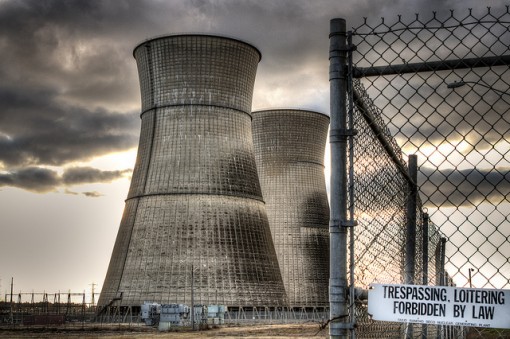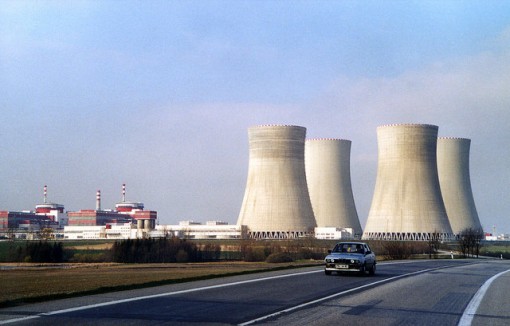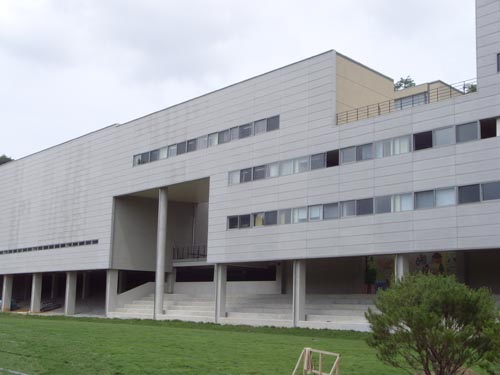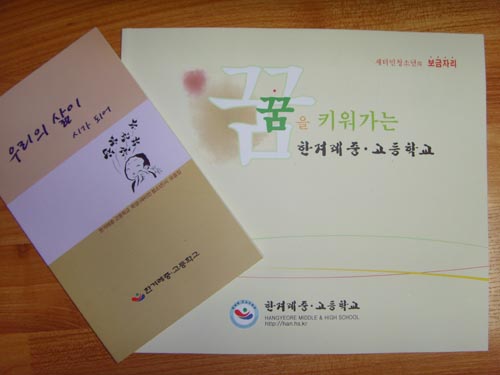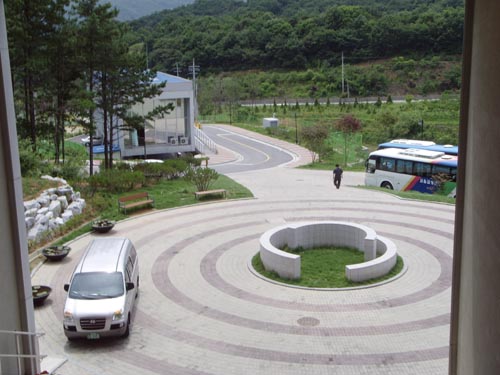Why Nuclear Power Must Be Part of the Energy Solution
BY RICHARD RHODES • JULY 19, 2018
Many environmentalists have opposed nuclear power, citing its dangers and the difficulty of disposing of its radioactive waste. But a Pulitzer Prize-winning author argues that nuclear is safer than most energy sources and is needed if the world hopes to radically decrease its carbon emissions.
In the late 16th century, when the increasing cost of firewood forced ordinary Londoners to switch reluctantly to coal, Elizabethan preachers railed against a fuel they believed to be, literally, the Devil’s excrement. Coal was black, after all, dirty, found in layers underground — down toward Hell at the center of the earth — and smelled strongly of sulfur when it burned. Switching to coal, in houses that usually lacked chimneys, was difficult enough; the clergy’s outspoken condemnation, while certainly justified environmentally, further complicated and delayed the timely resolution of an urgent problem in energy supply.
For too many environmentalists concerned with global warming, nuclear energy is today’s Devil’s excrement. They condemn it for its production and use of radioactive fuels and for the supposed problem of disposing of its waste. In my judgment, their condemnation of this efficient, low-carbon source of baseload energy is misplaced. Far from being the Devil’s excrement, nuclear power can be, and should be, one major component of our rescue from a hotter, more meteorologically destructive world.
Like all energy sources, nuclear power has advantages and disadvantages. What are nuclear power’s benefits? First and foremost, since it produces energy via nuclear fission rather than chemical burning, it generates baseload electricity with no output of carbon, the villainous element of global warming. Switching from coal to natural gas is a step toward decarbonizing, since burning natural gas produces about half the carbon dioxide of burning coal. But switching from coal to nuclear power is radically decarbonizing, since nuclear power plants release greenhouse gases only from the ancillary use of fossil fuels during their construction, mining, fuel processing, maintenance, and decommissioning — about as much as solar power does, which is about 4 to 5 percent as much as a natural gas-fired power plant.
Nuclear power releases less radiation into the environment than any other major energy source.
Second, nuclear power plants operate at much higher capacity factors than renewable energy sources or fossil fuels. Capacity factor is a measure of what percentage of the time a power plant actually produces energy. It’s a problem for all intermittent energy sources. The sun doesn’t always shine, nor the wind always blow, nor water always fall through the turbines of a dam.
In the United States in 2016, nuclear power plants, which generated almost 20 percent of U.S. electricity, had an average capacity factor of 92.3 percent, meaning they operated at full power on 336 out of 365 days per year. (The other 29 days they were taken off the grid for maintenance.) In contrast, U.S. hydroelectric systems delivered power 38.2 percent of the time (138 days per year), wind turbines 34.5 percent of the time (127 days per year) and solar electricity arrays only 25.1 percent of the time (92 days per year). Even plants powered with coal or natural gas only generate electricity about half the time for reasons such as fuel costs and seasonal and nocturnal variations in demand. Nuclear is a clear winner on reliability.
Third, nuclear power releases less radiation into the environment than any other major energy source. This statement will seem paradoxical to many readers, since it’s not commonly known that non-nuclear energy sources release any radiation into the environment. They do. The worst offender is coal, a mineral of the earth’s crust that contains a substantial volume of the radioactive elements uranium and thorium. Burning coal gasifies its organic materials, concentrating its mineral components into the remaining waste, called fly ash. So much coal is burned in the world and so much fly ash produced that coal is actually the major source of radioactive releases into the environment.
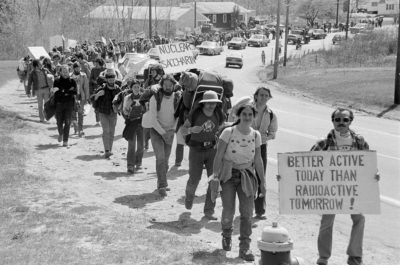
Anti-nuclear activists protest the construction of a nuclear power station in Seabrook, New Hampshire in 1977. AP PHOTO
In the early 1950s, when the U.S. Atomic Energy Commission believed high-grade uranium ores to be in short supply domestically, it considered extracting uranium for nuclear weapons from the abundant U.S. supply of fly ash from coal burning. In 2007, China began exploring such extraction, drawing on a pile of some 5.3 million metric tons of brown-coal fly ash at Xiaolongtang in Yunnan. The Chinese ash averages about 0.4 pounds of triuranium octoxide (U3O8), a uranium compound, per metric ton. Hungary and South Africa are also exploring uranium extraction from coal fly ash.

ALSO ON YALE E360
Industry Meltdown: Is the era of nuclear power coming to an end? Read more.
What are nuclear’s downsides? In the public’s perception, there are two, both related to radiation: the risk of accidents, and the question of disposal of nuclear waste.
There have been three large-scale accidents involving nuclear power reactors since the onset of commercial nuclear power in the mid-1950s: Three-Mile Island in Pennsylvania, Chernobyl in Ukraine, and Fukushima in Japan.
Studies indicate even the worst possible accident at a nuclear plant is less destructive than other major industrial accidents.
The partial meltdown of the Three-Mile Island reactor in March 1979, while a disaster for the owners of the Pennsylvania plant, released only a minimal quantity of radiation to the surrounding population. According to the U.S. Nuclear Regulatory Commission:
“The approximately 2 million people around TMI-2 during the accident are estimated to have received an average radiation dose of only about 1 millirem above the usual background dose. To put this into context, exposure from a chest X-ray is about 6 millirem and the area’s natural radioactive background dose is about 100-125 millirem per year… In spite of serious damage to the reactor, the actual release had negligible effects on the physical health of individuals or the environment.”
The explosion and subsequent burnout of a large graphite-moderated, water-cooled reactor at Chernobyl in 1986 was easily the worst nuclear accident in history. Twenty-nine disaster relief workers died of acute radiation exposure in the immediate aftermath of the accident. In the subsequent three decades, UNSCEAR — the United Nations Scientific Committee on the Effects of Atomic Radiation, composed of senior scientists from 27 member states — has observed and reported at regular intervals on the health effects of the Chernobyl accident. It has identified no long-term health consequences to populations exposed to Chernobyl fallout except for thyroid cancers in residents of Belarus, Ukraine and western Russia who were children or adolescents at the time of the accident, who drank milk contaminated with 131iodine, and who were not evacuated. By 2008, UNSCEAR had attributed some 6,500 excess cases of thyroid cancer in the Chernobyl region to the accident, with 15 deaths. The occurrence of these cancers increased dramatically from 1991 to 1995, which researchers attributed mostly to radiation exposure. No increase occurred in adults.
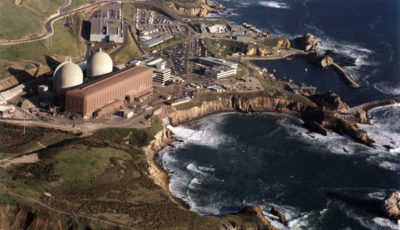
The Diablo Canyon Nuclear Power Plant, located near Avila Beach, California, will be decommissioned starting in 2024. PACIFIC GAS AND ELECTRIC
“The average effective doses” of radiation from Chernobyl, UNSCEAR also concluded, “due to both external and internal exposures, received by members of the general public during 1986-2005 [were] about 30 mSv for the evacuees, 1 mSv for the residents of the former Soviet Union, and 0.3 mSv for the populations of the rest of Europe.” A sievert is a measure of radiation exposure, a millisievert is one-one-thousandth of a sievert. A full-body CT scan delivers about 10-30 mSv. A U.S. resident receives an average background radiation dose, exclusive of radon, of about 1 mSv per year.
The statistics of Chernobyl irradiations cited here are so low that they must seem intentionally minimized to those who followed the extensive media coverage of the accident and its aftermath. Yet they are the peer-reviewed products of extensive investigation by an international scientific agency of the United Nations. They indicate that even the worst possible accident at a nuclear power plant — the complete meltdown and burnup of its radioactive fuel — was yet far less destructive than other major industrial accidents across the past century. To name only two: Bhopal, in India, where at least 3,800 people died immediately and many thousands more were sickened when 40 tons of methyl isocyanate gas leaked from a pesticide plant; and Henan Province, in China, where at least 26,000 people drowned following the failure of a major hydroelectric dam in a typhoon. “Measured as early deaths per electricity units produced by the Chernobyl facility (9 years of operation, total electricity production of 36 GWe-years, 31 early deaths) yields 0.86 death/GWe-year),” concludes Zbigniew Jaworowski, a physician and former UNSCEAR chairman active during the Chernobyl accident. “This rate is lower than the average fatalities from [accidents involving] a majority of other energy sources. For example, the Chernobyl rate is nine times lower than the death rate from liquefied gas… and 47 times lower than from hydroelectric stations.”
Nuclear waste disposal, although a continuing political problem, is not any longer a technological problem.

ALSO ON YALE E360
In Fukushima, a bitter legacy of radiation, trauma, and fear. Read more.
The accident in Japan at Fukushima Daiichi in March 2011 followed a major earthquake and tsunami. The tsunami flooded out the power supply and cooling systems of three power reactors, causing them to melt down and explode, breaching their confinement. Although 154,000 Japanese citizens were evacuated from a 12-mile exclusion zone around the power station, radiation exposure beyond the station grounds was limited. According to the report submitted to the International Atomic Energy Agency in June 2011:
“No harmful health effects were found in 195,345 residents living in the vicinity of the plant who were screened by the end of May 2011. All the 1,080 children tested for thyroid gland exposure showed results within safe limits. By December, government health checks of some 1,700 residents who were evacuated from three municipalities showed that two-thirds received an external radiation dose within the normal international limit of 1 mSv/year, 98 percent were below 5 mSv/year, and 10 people were exposed to more than 10 mSv… [There] was no major public exposure, let alone deaths from radiation.”
Nuclear waste disposal, although a continuing political problem in the U.S., is not any longer a technological problem. Most U.S. spent fuel, more than 90 percent of which could be recycled to extend nuclear power production by hundreds of years, is stored at present safely in impenetrable concrete-and-steel dry casks on the grounds of operating reactors, its radiation slowly declining.
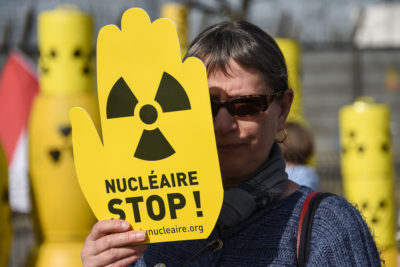
An activist in March 2017 demanding closure of the Fessenheim Nuclear Power Plant in France. Authorities announced in April that they will close the facility by 2020. SEBASTIEN BOZON / AFP / GETTY IMAGES
The U.S. Waste Isolation Pilot Plant (WIPP) near Carlsbad, New Mexico currently stores low-level and transuranic military waste and could store commercial nuclear waste in a 2-kilometer thick bed of crystalline salt, the remains of an ancient sea. The salt formation extends from southern New Mexico all the way northeast to southwestern Kansas. It could easily accommodate the entire world’s nuclear waste for the next thousand years.
Finland is even further advanced in carving out a permanent repository in granite bedrock 400 meters under Olkiluoto, an island in the Baltic Sea off the nation’s west coast. It expects to begin permanent waste storage in 2023.
A final complaint against nuclear power is that it costs too much. Whether or not nuclear power costs too much will ultimately be a matter for markets to decide, but there is no question that a full accounting of the external costs of different energy systems would find nuclear cheaper than coal or natural gas.

ALSO ON YALE E360
Rocky Flats: A wildlife refuge confronts its radioactive past. Read more.
Nuclear power is not the only answer to the world-scale threat of global warming. Renewables have their place; so, at least for leveling the flow of electricity when renewables vary, does natural gas. But nuclear deserves better than the anti-nuclear prejudices and fears that have plagued it. It isn’t the 21st century’s version of the Devil’s excrement. It’s a valuable, even an irreplaceable, part of the solution to the greatest energy threat in the history of humankind.

Richard Rhodes is the author of numerous books, including the recently published Energy: A Human History, and is the winner of the Pulitzer Prize, the National Book Award, and the National Book Critics Circle Award. Appearing as host and correspondent for documentaries on public television’s Frontline and American Experience series, he has also been a visiting scholar at Harvard, MIT, and Stanford University. MOREABOUT RICHARD RHODES →
TOPICS
Energy
GREENHOUSE GASES
NUCLEAR
PUBLIC HEALTH
ACTIVISM
POLITICS
REGIONS
North America
Asia
Europe
Join the conversation: Why Nuclear Power Must Be Part of the Energy SolutionShow comments →
Never miss a feature! Sign up for


